Did you know companies that use effective workforce planning can increase productivity by up to 30%? Workplace Planning Software helps you manage your human resources better, making your business more productive.
These software solutions cover the whole employee journey, from hiring to letting go. They help you make smart choices, keeping your business ahead. Using the right tools, you can handle the challenges of managing talent and keeping your organization running smoothly.
What is Workplace Planning Software?
Workplace planning software is a set of tools designed to make Employee Management Solutions more efficient. It helps manage, analyze, and track employee-related processes. This software lets companies handle recruitment, onboarding, performance reviews, and ending employment in a better way.
Workforce planning has three main parts: getting new employees, helping them grow, and letting them go. Putting all these steps into one system helps businesses have a better plan for their workers. This makes HR work smoother and improves the whole team's performance.
| Phase | Description | Key Functions |
| Acquisition | The process of attracting and hiring talent. | Recruitment tools, applicant tracking |
| Development | Enhancing skills and career growth for employees. | Performance management, training programs |
| Termination | The final stage when employment ends. | Offboarding processes, exit interviews |
Why is Workplace Planning Software Important?
Workforce planning tools help match human resources with business goals for better efficiency. Understanding what the workforce needs will help you make smart choices that help you reach your goals.
Workplace planning software also helps with labor management, including payroll, and automates HR tasks. This tech reduces manual work and lowers mistakes, making workforce data more reliable so companies can learn more about their people.
Using workforce planning tools lets companies grow with data-driven insights. Finding areas to improve, matching resources with needs, and planning for the future can help you increase productivity. Good workforce planning means happier employees and a strong company that can handle changes in the market.

Benefits of Workforce Planning Software
Workforce planning software changes how you manage your human resources. It smooths different processes and increases productivity, helping your team better achieve your business goals. Let's explore the main benefits.
Optimized Labor Cost Management
Workforce planning software is great at managing labor costs. It looks at your workforce data to help you decide on the right number of staff. This way, you keep productivity up without spending too much.
Strategic Workforce Development
This software helps you see what skills you'll need in the future. Strategic planning can prepare your team for new challenges. It's all about improving your workforce.
Effective Talent Management
The software analyzes talent management in detail. It tracks performance and skills to identify top employees. This helps you use your best people in the right places, improving your HR strengths.
More Targeted Recruitment Strategies
The software sharpens your recruitment methods with detailed analytics. You can focus on specific skills and groups, making sure your hiring fits your goals.
Improved Decision-Making with Data Insights
Having real-time data improves your decisions. Analytics lets you see workforce trends and adjust your plans, improving your operational efficiency.
Increased Employee Engagement
Workforce planning software improves employee engagement with personalized development plans. Happy employees add to your company's positive culture and motivate your team.
Improved Productivity
With better staffing and resource use, productivity goes up. Optimizing your workforce means everyone has a fair workload. This lets your team work at their best.
Streamlined Succession Planning
Succession planning is key to your organization's future. Workforce planning software helps you spot important roles and grow talent from within, making filling those roles smoother.
Adaptability to Market Changes
This software lets you quickly adjust to market changes. You can tweak your workforce plans with up-to-date industry data, keeping you competitive.
Improved Compliance with Labor Laws
The software ensures you follow labor laws and regulations. It keeps accurate records and monitors law changes, which avoids legal problems, which is a big plus for HR.

Top 10 Workforce Planning Software to Choose From
Selecting the right workforce planning software is essential for organizations aiming to optimize their talent management and resource allocation. Here is a list of the top 10 workforce planning software solutions to help businesses streamline operations and make data-driven decisions.
1. Kohezion

Kohezion is a customizable database management solution offering a flexible workforce planning platform. Designed for organizations of all sizes, Kohezion allows users to create applications tailored to their specific needs without requiring extensive technical knowledge. Its user-friendly interface and robust features make it an ideal choice for businesses looking to streamline their workforce planning processes and improve data-driven decision-making.
Top 5 Features:
- Customizable Applications: Create tailored applications to fit unique workforce planning needs.
- Data Visualization: Generate charts and reports for easy interpretation of workforce data.
- Role-Based Access Control: Ensure secure access to sensitive information with user-specific permissions.
- Collaboration Tools: Facilitate communication and information sharing among team members.
- Automated Workflows: Streamline repetitive tasks to improve efficiency.
5 Benefits:
- Improved Flexibility: Customize solutions to match specific business requirements.
- Better Collaboration: Share information easily among stakeholders to make informed decisions.
- Increased Efficiency: Automate tasks to save time and reduce manual errors.
- Better Decision-Making: Use data visualization tools for clear insights into workforce trends.
- Cost-Effective: Reduce the need for multiple software solutions with an all-in-one platform.
2 Cons:
- Learning Curve: May require initial training for users unfamiliar with database customization.
- Limited Pre-Built Templates: Fewer ready-made solutions compared to some competitors.
Best For:
Kohezion is best for small—to medium-sized businesses that require customizable workforce planning tools and a flexible, user-friendly platform to address specific organizational needs.
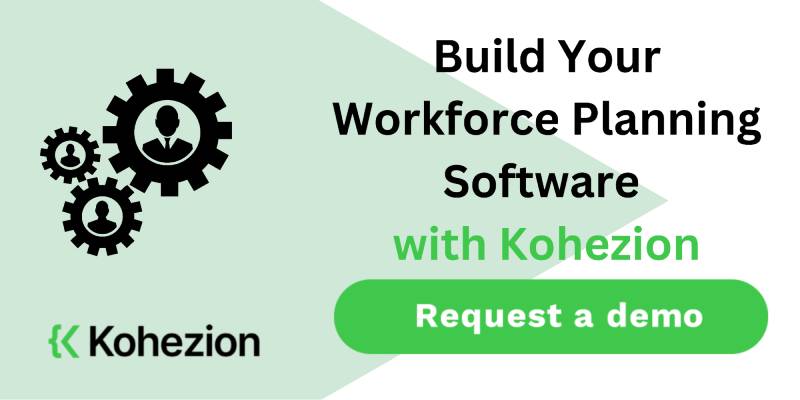
2. Runn
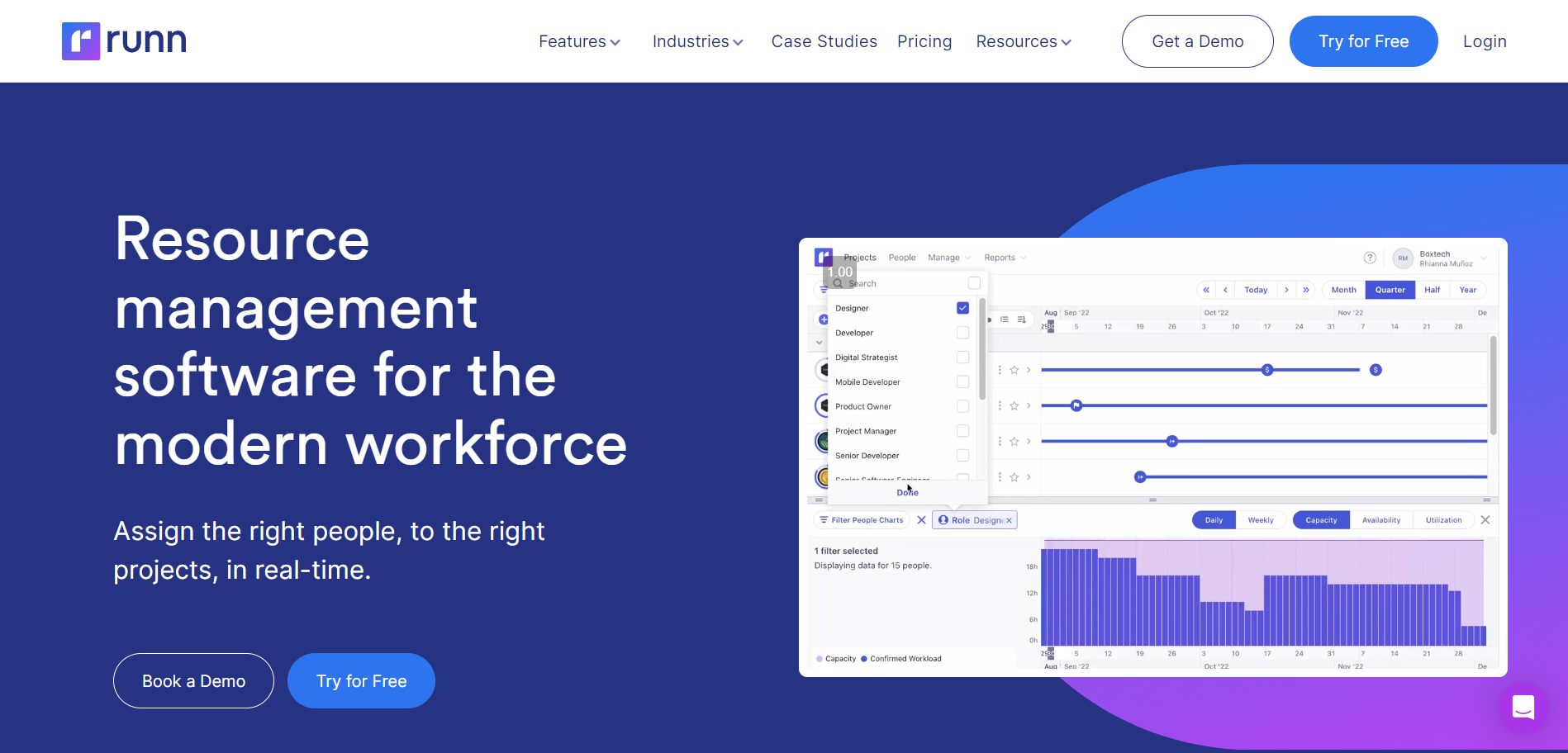
Runn is a cloud-based resource and workforce planning software designed for project-based businesses. It provides a comprehensive overview of staff availability, project timelines, and resource allocation to help companies optimize their workforce management. With its intuitive interface and real-time data updates, Runn enables managers to make informed decisions quickly and adapt to changing project requirements.
Top 5 Features:
- Resource Scheduling: Plan and allocate resources effectively across multiple projects.
- Real-Time Updates: Get instant visibility into project status and team availability.
- Forecasting Tools: Predict future resource needs and manage workload capacity.
- Time Tracking Integration: Connect with time tracking tools to monitor work hours.
- Budget Management: Track project budgets and expenses in real time.
5 Benefits:
- Improved Resource Utilization: Allocate resources efficiently to prevent overloading or underutilization.
- Better Project Management: Keep projects on track with real-time visibility into timelines and resources.
- Improved Forecasting: Anticipate future resource needs and adjust plans accordingly.
- Cost Control: Monitor project budgets and expenses to prevent overspending.
- Increased Collaboration: Share project information easily with team members and stakeholders.
2 Cons:
- Limited Customization: May not offer as much customization as some competitors.
- Dependent on Internet Connectivity: Requires a stable internet connection for optimal performance.
Best For:
Runn is best for project-based businesses, such as agencies and consultancies, that manage resources and timelines efficiently across multiple projects.
3. Agentnoon
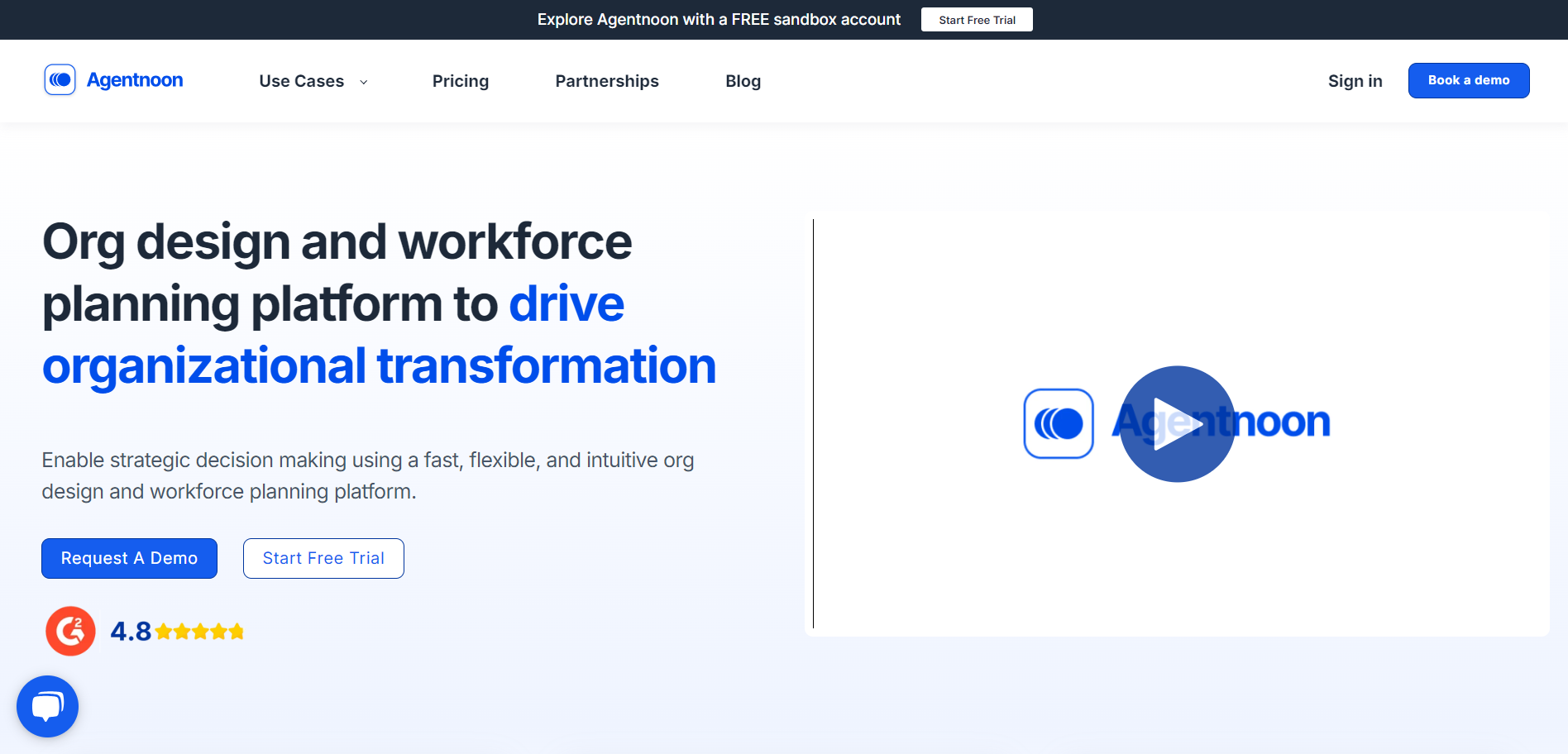
Agentnoon is a workforce planning and analytics platform designed to provide HR teams with valuable insights into their workforce. It offers tools for headcount planning, talent analytics, and diversity tracking, making it a comprehensive solution for strategic workforce management. With its focus on data-driven decision-making, Agentnoon helps organizations align their workforce strategies with business goals.
Top 5 Features:
- Headcount Planning: Plan and forecast workforce needs based on business goals.
- Talent Analytics: Analyze employee performance and identify skill gaps.
- Diversity Tracking: Monitor diversity metrics to support inclusion initiatives.
- Customizable Dashboards: Create personalized dashboards for data visualization.
- Integration Capabilities: Connect with HRIS and other systems for seamless data flow.
5 Benefits:
- Strategic Workforce Planning: Align workforce strategies with long-term business objectives.
- Improved Talent Management: Identify and address skill gaps for better talent development.
- Improved Diversity Initiatives: Track and improve diversity metrics within the organization.
- Data-Driven Decisions: Use analytics to make informed HR decisions.
- Seamless Integration: Ensure smooth data flow between systems for accurate insights.
2 Cons:
- Complex Setup: May require initial setup and configuration to integrate with existing systems.
- Cost: Pricing may be high for smaller organizations with limited budgets.
Best For:
Agentnoon is best for mid-sized to large enterprises looking to improve their workforce planning with data-driven insights and improve diversity and inclusion efforts.
4. Deel

Deel is a global payroll and compliance platform that simplifies workforce management for businesses with remote and international teams. It provides tools for hiring, paying, and managing employees and contractors worldwide, ensuring compliance with local labor laws. Deel's user-friendly platform helps businesses expand globally without the complexities of traditional HR processes.
Top 5 Features:
- Global Payroll: Process payments for employees and contractors in multiple countries.
- Compliance Management: Ensure compliance with local labor laws and tax regulations.
- Contractor Management: Onboard and manage contractors with ease.
- Integration Options: Connect with popular HR and accounting tools for seamless workflows.
- Expense Tracking: Manage and reimburse employee expenses efficiently.
5 Benefits:
- Simplified Global Expansion: Hire and manage international teams without legal complications.
- Reduced Compliance Risks: Stay compliant with local labor laws and avoid penalties.
- Efficient Contractor Management: Streamline onboarding and payment processes for contractors.
- Improved Payroll Accuracy: Ensure timely and accurate payments to employees worldwide.
- Cost Savings: Reduce administrative overhead associated with global workforce management.
2 Cons:
- Limited HR Features: Primarily focused on payroll and compliance, may lack broader HR functionalities.
- Complex Pricing Structure: Pricing can vary based on location and service level.
Best For:
Deel is best for companies with remote or international teams needing a streamlined global payroll and compliance management solution.
5. Planday

Planday is a workforce scheduling and management platform that helps businesses streamline staff scheduling, communication, and time tracking. It offers tools for creating schedules, tracking employee hours, and managing labor costs, making it ideal for industries with shift-based workforces. Planday's mobile app allows employees to access schedules, swap shifts, and communicate with managers on the go.
Top 5 Features:
- Shift Scheduling: Create and manage employee schedules with ease.
- Time Tracking: Monitor employee hours and attendance in real time.
- Mobile Access: Allow employees to access schedules and communicate via mobile app.
- Labor Cost Management: Track and control labor costs to stay within budget.
- Integration Capabilities: Connect with payroll and HR systems for seamless operations.
5 Benefits:
- Efficient Scheduling: Save time creating and managing shift schedules.
- Improved Communication: Facilitate better communication between employees and managers.
- Cost Control: Monitor labor costs to prevent overspending and stay profitable.
- Improved Employee Engagement: Empower employees with mobile access to schedules and shift swaps.
- Compliance Assurance: Ensure compliance with labor laws and regulations.
2 Cons:
- Limited Customization: May not offer as much flexibility as some competitors.
- Dependence on the Internet: Requires internet connectivity for optimal use.
Best For:
Planday is best for businesses with shift-based workforces, such as restaurants, retail, and healthcare, that need efficient scheduling and labor cost management.
6. Lightcast
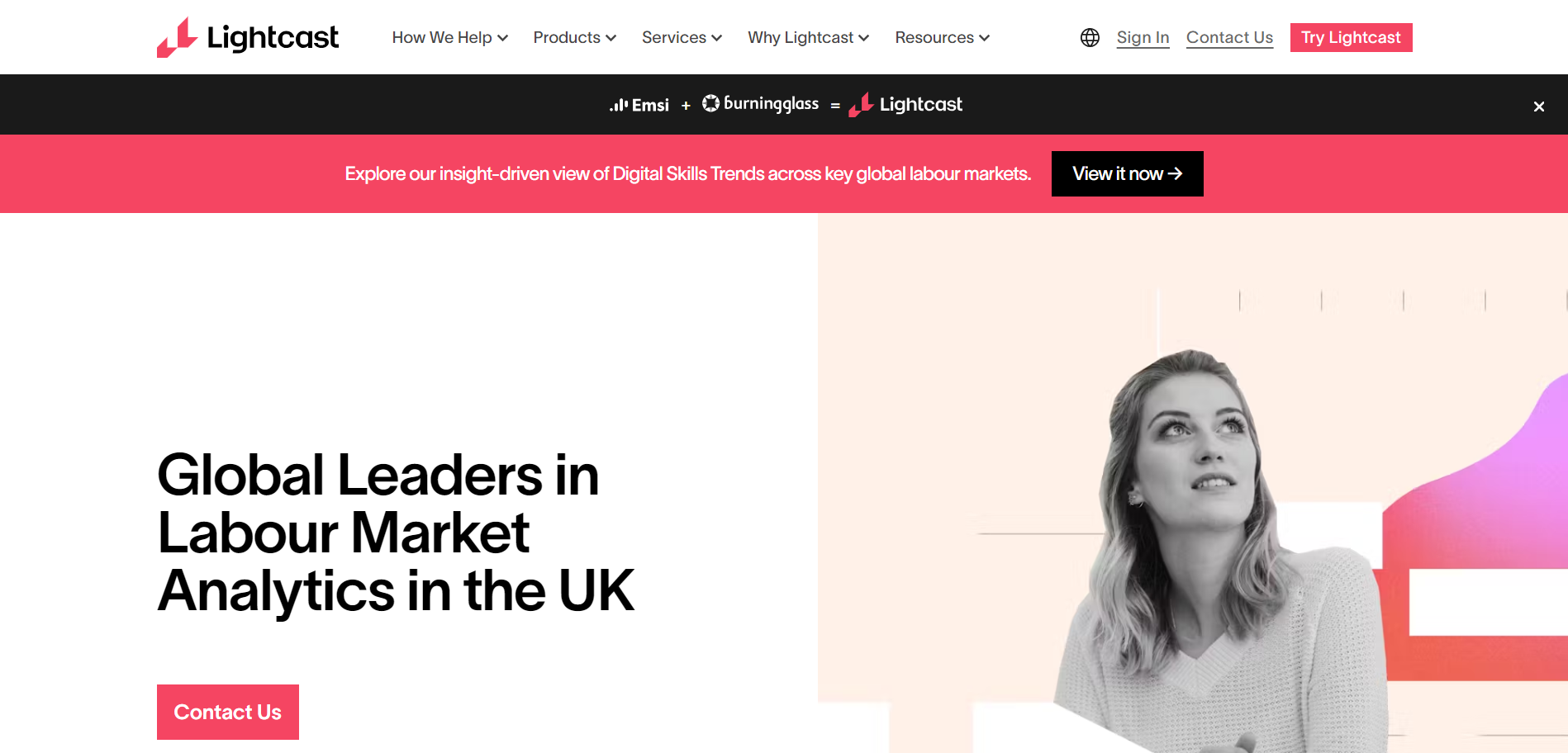
Lightcast is a workforce planning and analytics software that provides insights into labor market trends and workforce dynamics. It offers tools for talent acquisition, skill development, and workforce optimization, helping organizations make informed decisions about their workforce strategies. Lightcast's data-driven approach enables businesses to align their workforce planning with market demands and business goals.
Top 5 Features:
- Labor Market Analytics: Access real-time labor market data for informed decision-making.
- Workforce Optimization: Identify opportunities to optimize workforce utilization.
- Talent Acquisition Tools: Improve recruitment efforts with data-driven insights.
- Skill Development Insights: Analyze skill gaps and plan for employee development.
- Customizable Reports: Generate reports tailored to specific business needs.
5 Benefits:
- Informed Workforce Strategies: Use market data to align workforce planning with business goals.
- Improved Talent Acquisition: Improve recruitment efforts with insights into labor market trends.
- Better Skill Development: Address skill gaps and plan for employee training and development.
- Optimized Workforce Utilization: Identify opportunities to improve workforce efficiency.
- Data-Driven Decisions: Make informed decisions with comprehensive analytics and reports.
2 Cons:
- Complex Data Analysis: May require expertise in data analysis to fully leverage insights.
- High Cost: Pricing may be high for smaller organizations with limited budgets.
Best For:
Lightcast is best for medium—to large enterprises that want to leverage labor market data and analytics to inform their workforce planning and talent acquisition strategies.
7. Planful

Planful is a cloud-based financial planning and analysis platform that helps businesses streamline their budgeting, forecasting, and reporting processes. While primarily focused on finance, Planful offers workforce planning capabilities to align human resources with financial goals. Its user-friendly interface and robust features make it a valuable tool for organizations looking to integrate workforce planning with broader financial strategies.
Top 5 Features:
- Budgeting and Forecasting: Streamline financial planning processes with integrated workforce planning.
- Workforce Analytics: Analyze workforce data to align HR strategies with financial goals.
- Scenario Modeling: Evaluate different workforce scenarios to plan for future needs.
- Collaboration Tools: Facilitate communication and collaboration across departments.
- Integration Options: Connect with existing HR and financial systems for seamless data flow.
5 Benefits:
- Integrated Planning: Align workforce planning with financial strategies for holistic decision-making.
- Improved Forecasting: Use data-driven insights to predict workforce needs and budget accordingly.
- Better Collaboration: Foster communication and collaboration between HR and finance teams.
- Cost Control: Monitor and manage workforce costs to stay within budget.
- Better Decision-Making: Use analytics and modeling to make informed workforce decisions.
2 Cons:
- Finance Focused: Primarily designed for financial planning, may lack some HR-specific features.
- Complex Setup: Initial setup and integration with existing systems may require time and resources.
Best For:
Planful is best for mid-sized to large enterprises seeking to integrate workforce planning with financial strategies and improve collaboration between HR and finance teams.
8. Visier
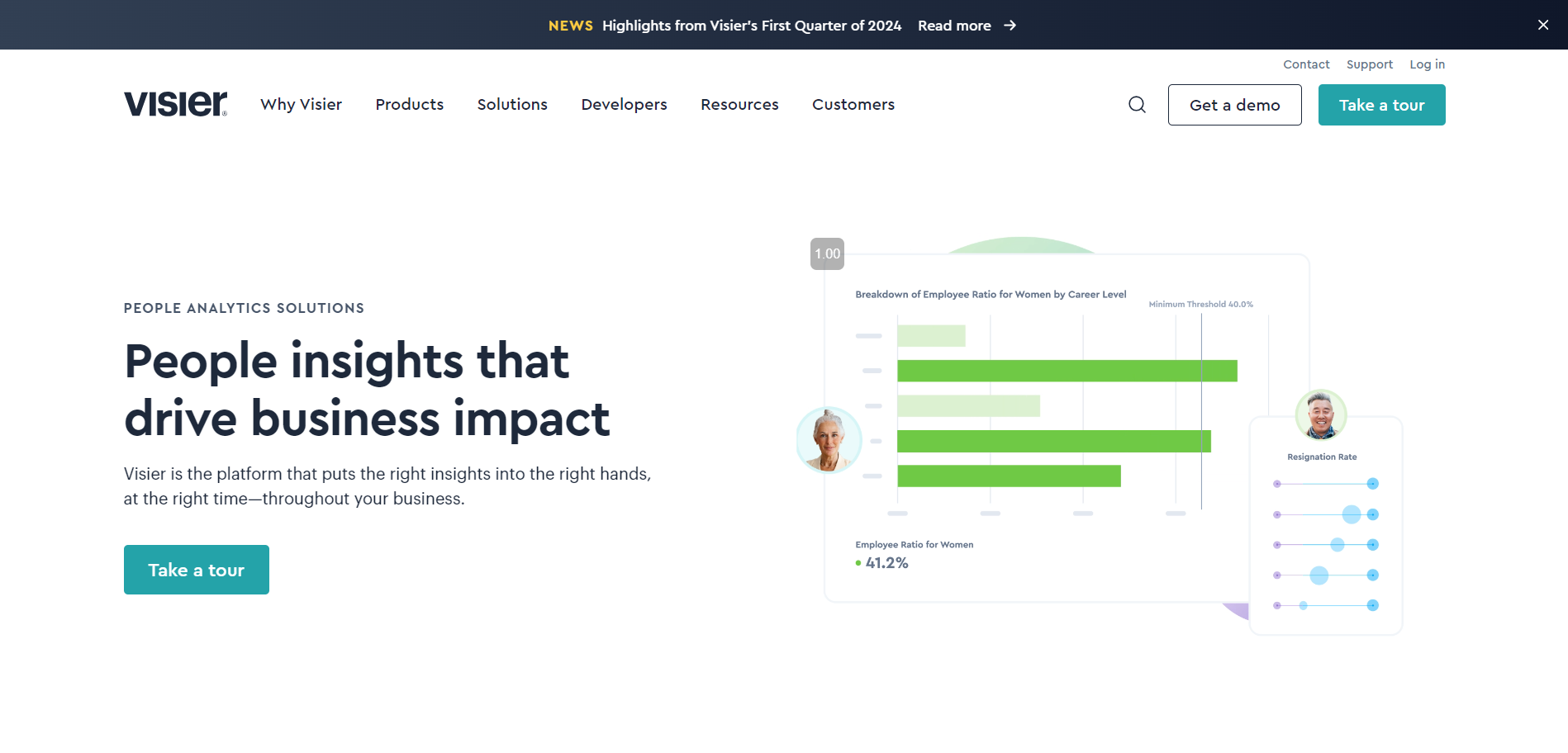
Visier is a workforce analytics and planning platform designed to provide organizations with deep insights into their workforce data. It offers tools for headcount planning, diversity and inclusion analysis, and talent management, helping businesses make data-driven HR decisions. With its user-friendly interface and advanced analytics capabilities, Visier empowers HR teams to align their strategies with business objectives.
Top 5 Features:
- Workforce Analytics: Access detailed insights into workforce data and trends.
- Headcount Planning: Plan and forecast staffing needs based on business goals.
- Diversity and Inclusion Analysis: Track diversity metrics and support inclusion initiatives.
- Talent Management Tools: Analyze employee performance and identify skill gaps.
- Customizable Dashboards: Create personalized dashboards for data visualization.
5 Benefits:
- Data-Driven Decisions: Make informed HR decisions with comprehensive workforce analytics.
- Improved Talent Management: Identify and address skill gaps for better employee development.
- Improved Diversity Initiatives: Support diversity and inclusion efforts with data insights.
- Strategic Workforce Planning: Align workforce strategies with long-term business objectives.
- Seamless Integration: Connect with existing HRIS and systems for accurate data insights.
2 Cons:
- Complex Data Analysis: May require expertise in data analysis to fully leverage insights.
- Cost: Pricing may be high for smaller organizations with limited budgets.
Best For:
Visier is best for mid-sized to large enterprises seeking to improve their workforce planning and talent management strategies with data-driven insights.
9. Orgvue
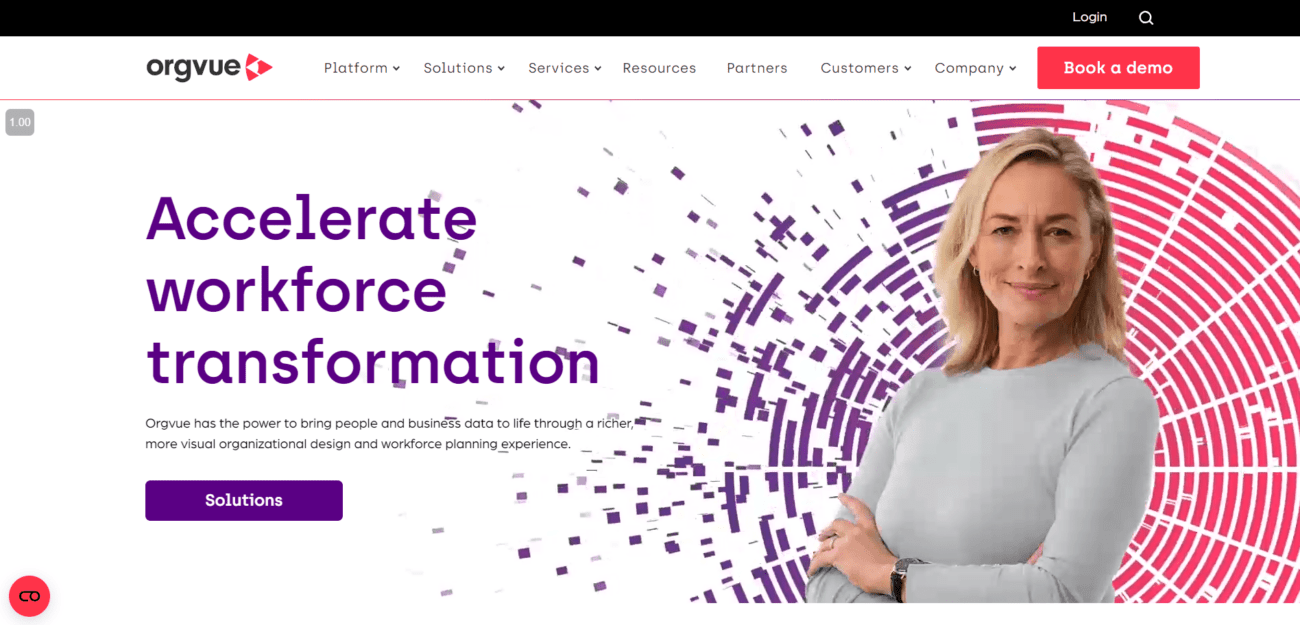
Orgvue is a workforce analytics and planning platform that helps organizations visualize and optimize their workforce structures. It provides tools for organizational design, scenario modeling, and workforce optimization, enabling businesses to align their workforce strategies with business goals. With its focus on data visualization and analytics, Orgvue empowers HR teams to make informed decisions about workforce planning and management.
Top 5 Features:
- Organizational Design: Visualize and optimize workforce structures for better alignment.
- Scenario Modeling: Evaluate different workforce scenarios to plan for future needs.
- Workforce Optimization: Identify opportunities to improve workforce efficiency and utilization.
- Data Visualization: Create charts and reports for easy interpretation of workforce data.
- Integration Capabilities: Connect with existing HR and financial systems for seamless data flow.
5 Benefits:
- Improved Workforce Alignment: Align workforce structures with business goals for better outcomes.
- Improved Decision-Making: Use data visualization to make informed workforce decisions.
- Optimized Workforce Utilization: Identify opportunities to improve efficiency and productivity.
- Strategic Planning: Plan for future workforce needs with scenario modeling and forecasting.
- Seamless Integration: Ensure accurate data insights with integration capabilities.
2 Cons:
- Complex Setup: Initial setup and integration with existing systems may require time and resources.
- Cost: Pricing may be high for smaller organizations with limited budgets.
Best For:
Orgvue is best for mid-sized to large enterprises looking to optimize their workforce structures and align their strategies with business goals using data visualization and analytics.
10. ChartHop
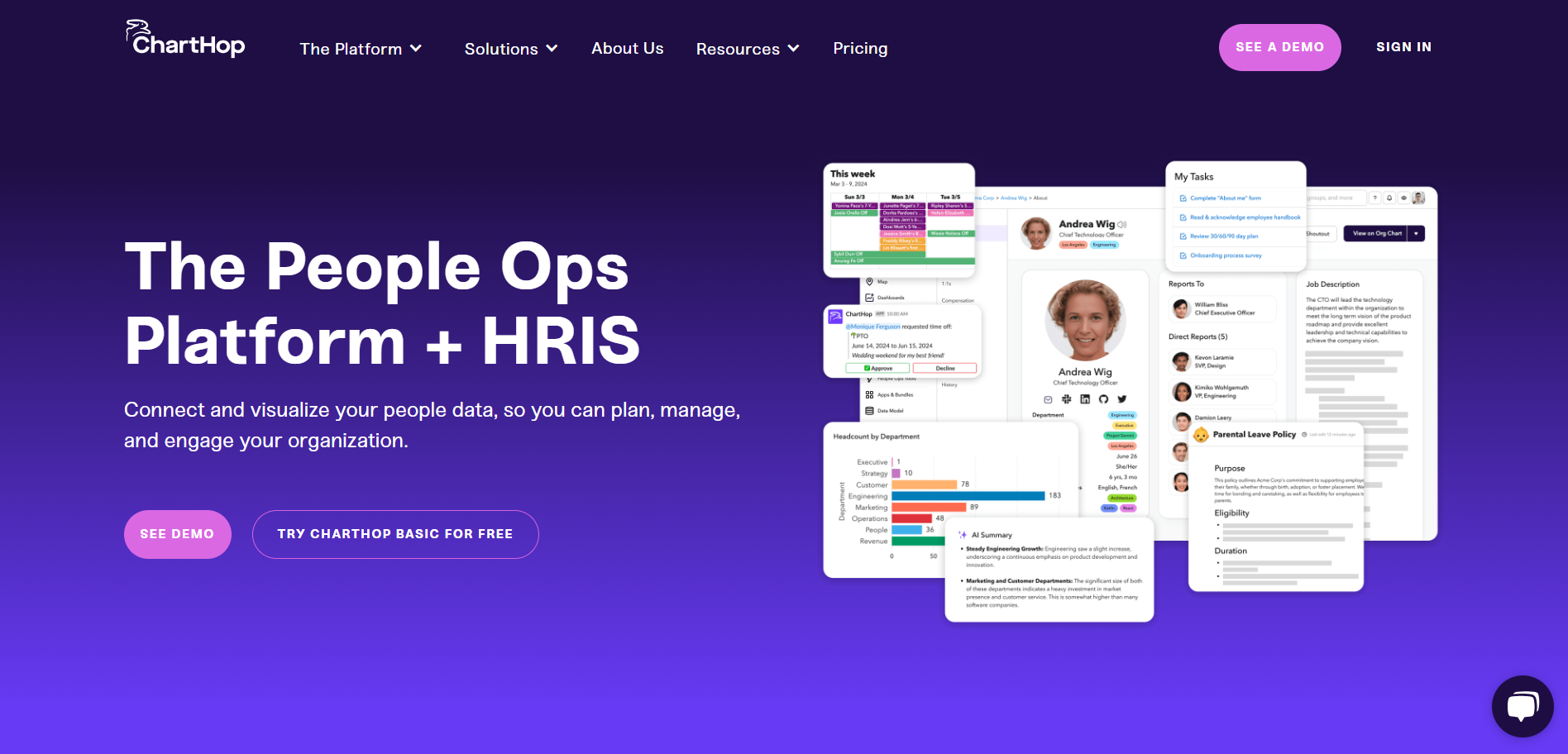
ChartHop is a workforce planning and analytics platform designed to provide organizations with a comprehensive view of their workforce data. It offers tools for headcount planning, performance management, and diversity tracking, helping businesses make data-driven HR decisions. With its user-friendly interface and customizable dashboards, ChartHop empowers HR teams to align their strategies with business objectives.
Top 5 Features:
- Workforce Analytics: Access detailed insights into workforce data and trends.
- Headcount Planning: Plan and forecast staffing needs based on business goals.
- Diversity Tracking: Monitor diversity metrics to support inclusion initiatives.
- Performance Management Tools: Analyze employee performance and identify skill gaps.
- Customizable Dashboards: Create personalized dashboards for data visualization.
5 Benefits:
- Data-Driven Decisions: Make informed HR decisions with comprehensive workforce analytics.
- Improved Talent Management: Identify and address skill gaps for better employee development.
- Improved Diversity Initiatives: Support diversity and inclusion efforts with data insights.
- Strategic Workforce Planning: Align workforce strategies with long-term business objectives.
- Seamless Integration: Connect with existing HRIS and systems for accurate data insights.
2 Cons:
- Complex Data Analysis: May require expertise in data analysis to fully leverage insights.
- Cost: Pricing may be high for smaller organizations with limited budgets.
Best For:
ChartHop is best for mid-sized to large enterprises seeking to improve their workforce planning and talent management strategies with data-driven insights and improve diversity and inclusion efforts.
Top Features in Workplace Planning Software
Understanding the key features of workforce planning software helps you use it fully. These tools are essential for managing and developing your team strategically.
Predicting Workforce Needs
Using metrics and past data, workforce planning software can predict your team's needs. This lets you fill gaps and avoid extra staff, keeping your team balanced.
Scenario Planning
Scenario planning helps your team prepare for different work situations. It lets you plan for challenges and stay flexible, keeping your team ready for anything.
Identifying Skill Gaps
This software compares what your team can do with what they need to do, helping you spot skill gaps. It also guides training, helping your team’s growth and progress.
Succession Planning
Succession planning ensures your team continues to run smoothly when leaders change. This feature finds and prepares future leaders with specific plans.
Employee Development and Training
This software makes training and developing employees easier. You can create programs that fit their needs and your company's goals.
Demand Forecasting
Forecasting demand uses past data and trends to guess future needs, helping you plan your team right.
Workforce Analytics
Workforce analytics give deep insights into how your team works and feels. These insights help you make smart decisions and keep your team strong.
Compliance Management
Following labor laws is a must for any business. This software helps you stay compliant, lowering the risk of legal issues.
Seamless Integrations
Linking your software with other systems improves its performance, improves data sharing, and makes managing your business easier.
Real-Time Data and Reporting
Having up-to-date data and reports helps you make quick decisions. This feature keeps you informed about your team, helping you react quickly to changes.
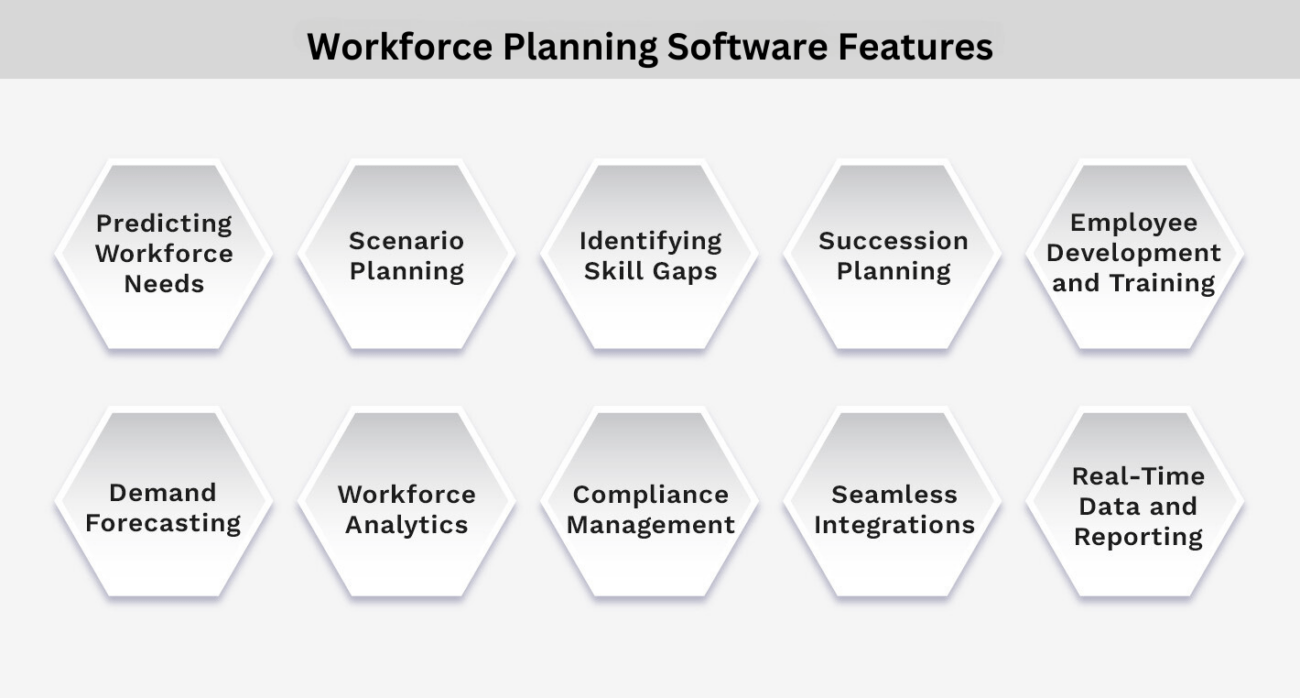
How to Choose the Right Workforce Planning Software for Your Business
Choosing the right workforce planning software will ensure you meet your business needs and improve your HR and make things more efficient. Here are important things to think about:
Identify Your Needs
Examine your business's real needs and determining which features are important for your goals. Knowing this will help you choose a system that will make your work easier and your team better.
Consider Integration Options
Make sure the workforce planning software connects smoothly with your existing software. This will improve performance and help your team easily use the new software.
Assess Usability
It's important that the software is easy to use. You want your team to pick it up fast and use it well. A simple interface means less training and better use across your company.
Factor in Scalability
Your software should be able to grow with your business. It needs to handle more work or changes in your company's structure. Look for options that are flexible and can change or grow with you.
Manage Your Workforce with Kohezion
Kohezion is a powerful tool that streamlines employee data and processes. It lets you customize workflows to fit your business needs.
The benefits of Kohezion software go beyond just managing data. It helps improve team collaboration. This leads to better communication and engagement among employees. Kohezion gives you insights into workforce performance, helping you make smart decisions.
| Feature | Description | Benefits |
| Customizable Templates | Create templates for tracking various HR processes. | Increased efficiency and tailored workflows. |
| Data Insights | Access real-time analytics on employee performance. | Informed decision-making and strategy refinement. |
| Collaboration Tools | Facilitate teamwork and communication among staff. | Improved employee engagement and productivity. |
| Streamlined HR Operations | Automate daily tasks and manage employee information. | Reduced administrative burden and time savings. |
Conclusion
Workplace planning software is key to improving your organization's performance and managing talent well. It helps cut labor costs and ensure compliance, making it a strong foundation for your HR strategies.
Choosing the right software helps you deal with today's complex workforce issues. Using these tools, you help your company use its people to the fullest. This means better decisions, smarter hiring, and happier employees.
Using workforce planning software is more than just managing people. It's about pushing your business forward in a changing world. Contact Kohezion today and make a smart move for success.
Start building with a free account
Frequently Asked Questions
Workforce planning and workforce management are related but focus on different areas. Workforce planning involves forecasting future staffing needs and developing strategies to meet those needs, including hiring, training, and development. It focuses on long-term goals and aligning the workforce with business objectives. Workforce management, on the other hand, deals with day-to-day operations, such as scheduling, attendance tracking, and ensuring that current staff is used efficiently to meet immediate business demands.
External factors like economic trends can significantly impact workforce planning. For instance, during economic downturns, a company might need to adjust its hiring plans and focus on retaining and retraining existing employees. Conversely, in a growing economy, a business might plan to expand its workforce to capitalize on new opportunities. Changes in technology, labor laws, and industry regulations are external factors that can affect workforce planning.
Yes, workforce planning software can help identify skill gaps within a company. These tools analyze current employee skills, performance data, and future business needs to pinpoint areas where additional training or hiring is required. They can also help track employee development and match skill sets with job requirements, ensuring the workforce is equipped to meet the organization's goals. This helps companies address skill shortages proactively and supports strategic talent development.

